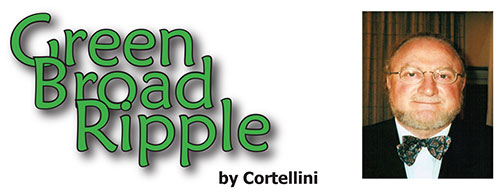
|
Broad Ripple Random Ripplings

The news from Broad Ripple
Brought to you by The Broad Ripple Gazette
(Delivering the news since 2004, every two weeks)

|
| Brought to you by: |

|

|

|

|

|

|
Converted from paper version of the Broad Ripple Gazette (v04n02)
Green Broad Ripple - Buildings-Quality - by Cortellini
posted: Jan. 26, 2007

Buildings-Quality
What transforms a structure into a building of quality? Andrea Palladio, arguably the most imitated architect in history and the author of "The Four Books of Architecture", which was published in 1576, wrote "For one could not describe as perfect a building which was useful, but only briefly, or one that was inconvenient for a long time, or, being both durable and useful, was not beautiful." For Palladio, a man famous for the beauty of his buildings, beauty was not something intentionally imparted. Rather, it became manifest in buildings that were both useful and durable. Usefulness and Durability were, for him, the hallmarks of "Quality".
Usefulness is more complicated than it appears at first sight. To make a building truly useful the design must be thoroughly informed in the activities and processes that the building must accommodate. It must anticipate how internal dynamics, such as growth - and external dynamics, such as weather, on timescales from years to centuries, might come to bear. It must provide for the comfort, health and safety of its occupant. Beyond the practical, a useful building must speak to spiritual and emotional life as well and make a positive contribution to the community.
Durability is assured through the application of craftsmanship, which begins with the development of adequate plans for the construction process. This is followed by gathering the best possible materials for the given application and budget, then assembling the components with care and skill. Thus constructed, a building assumes an integrity that extends its life for many generations.
The nature of buildings is implied by the intricacy of the word itself. The word "Building" is both a noun and a verb - both the process and the result. A building exists as an object, yet is never quite complete because "Building" as process is perpetually at work; maintenance, repair, remodel, refurbish. . . all are part of the "Building" until overtaken by the finality of demolition. Continually changing and evolving, buildings are alive through the symbiotic relationship they have with humans.
Generally, buildings fall into one of three categories - domestic, commercial, or institutional, each exhibiting a unique type of quality. They all live and change, but do so at different rates and for different reasons. Domestic buildings - houses - reflect the intimacy of family relations. Their rhythm of change is synchronized to the changes of the family within. A new family member arrives; Junior goes to college, Grandmother moves in... . Houses change as the family changes. Houses are capable of exhibiting a considerable amount of quality; in Broad Ripple, this is tied more to the expression of honesty and integrity than opulence and extravagance. Many homes in Broad Ripple are quite beautiful in their simple elegance and unaffected honesty.
Commercial buildings are, by nature, metamorphic. They need to be. As businesses come and go they must adapt. As businesses grow they must accommodate. As new technologies develop, they must incorporate. Their lives are subject to the same intense competitive pressures as the businesses they harbor. It is most difficult and unusual for these buildings to invest in any serious amount of durability. It is much more convenient and cost effective to rely on cheap imitation (the enemy of quality) to create the illusion of quality. Or they may promote 'shabby chic' or other devices as acceptable alternatives to quality. A number of buildings in Broad Ripple are of this sort. Can you spot them?
Institutional buildings tend to be stoic edifices that project propriety and rectitude. They reflect the need of the institution within to covey timeless reliability. They are mortified by change and only come to it, as they must, with great difficulty and expense. Built in 1907, the former Masonic Lodge on the corner of Guilford and Broad Ripple Avenue is such a building. Its classic presence and substantial construction speak well of its durability. Yet today it tells a woeful story, for its original lofty usefulness is no longer required. Its personality is poorly suited to the undignified nature of the business that it is forced to accommodate.
In our dynamic business oriented time, Palladio's notions of quality may seem, to some, to have lost their relevance. Yet the Green movement, the latest thinking on the quality of buildings, recognizes that Usefulness and Durability are important elements not only in quality but also in sustainability.
Cortellini is a licensed architect in the states of Indiana and Arizona. He holds a BFA from Indiana University Herron School of Art. He has taught architectural technology at the college level at several universities and has pursued independent artistic endeavors. His architectural practice has focused on residential and small commercial projects. He has recently committed his practice to designing Green buildings, is a member of the US Green Building Council and is a LEED Accredited Professional. Send questions/comments to cortellini@BroadRippleGazette.com
cortellini@broadripplegazette.com

|

|

|
| Brought to you by: |

|

|

|
| Brought to you by: |

|

|

|


